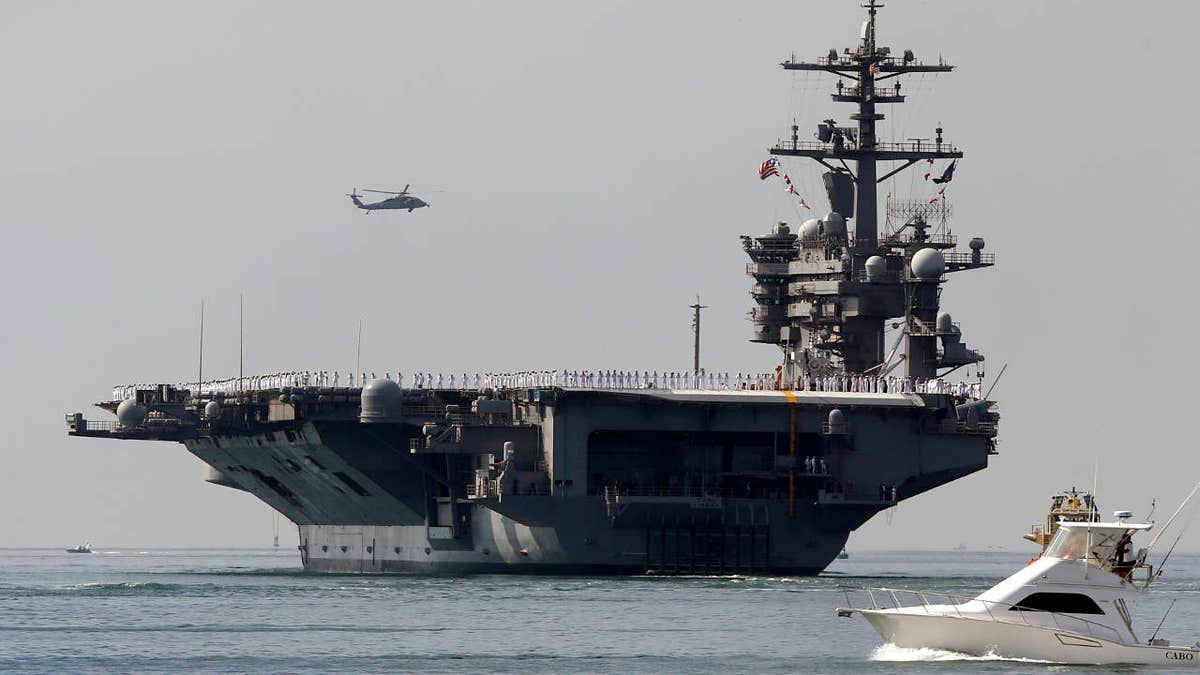
FILE - In this Aug. 22, 2014 file photo, the aircraft carrier USS Carl Vinson sails out of San Diego Harbor leaving for a nine month deployment in San Diego. (AP)
The U.S. Navy sent an aircraft carrier and guided-missile destroyer to patrol the South China Sea over the weekend, for the first time since President Trump took office, military officials confirmed.
TILLERSON HOLDS FIRST SET OF TALKS WITH CHINESE COUNTERPART
The USS Carl Vinson carrier was joined by the USS Wayne E. Meyer and aircraft from Carrier Air Wing 2. Navy officials said the previously scheduled operations, which got underway Saturday, were routine.
In January, during his confirmation hearing for secretary of state, Rex Tillerson said China should be denied access to its man-made islands in the South China Sea, where China has installed runways on three islands and bunkers to house fighter jets and bombers. The Pentagon is closely monitoring to see if China deploys surface-to-air missiles next, which could affect U.S. Navy flight operations in the region.
VIDEO SHOWING APPARENT POISONING OF KIM JONG UN'S HALF-BROTHER SURFACES
China has issued stark warnings to the U.S. and other nations to tread carefully. “China respects and upholds the freedom of navigation and overflight in the South China Sea, which countries enjoy under international law, but firmly opposes any country’s attempt to undermine China’s sovereignty and security in the name of the freedom of navigation and overflight,” foreign ministry spokesman Geng Shuang said.
The ships were likely to sail within the 12 nautical miles of China’s artificial islands, the Navy Times reported last week.
Navy warships have deliberately sailed close to Chinese-occupied features four times since October 2015. The first three missions challenged China's requirement for ships to obtain permission prior to transit, while the last one challenged China's sovereignty over waters encompassing the Paracels.
Defense Secretary Jim Mattis said recently that such operations would continue while also ruling out any military escalation.
"Any miscalculation from either side may escalate tensions, which could spin out of control," Zhiqun Zhu, who heads The China Institute at Bucknell University in Pennsylvania, told the Navy Times. "China is unlikely to cave in no matter what the U.S. military does in the South China Sea. Cooler heads are needed from both sides, not moves to unnecessarily provoke the other side."
China dispatched its own fleet for scheduled drills.
The missile destroyers Changsha and Haikou and the supply ship Luomahu wrapped up weeklong exercises on Friday. The fleet includes three helicopters and marines on board.
According to the official Xinhua News Agency, the drills involved naval aviation forces and military garrisons from the Spratlys and the Paracels, as well as elements of the Beihai and Donghai fleets. They practiced air defense, escorting, anti-terror, anti-piracy and defensive operations under real combat conditions, Xinhua said.
Fox News' Lucas Tomlinson and The Associated Press contributed to this report.




















